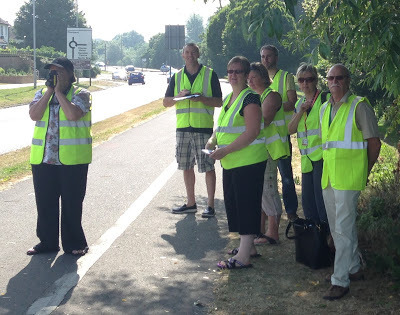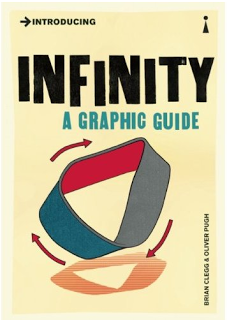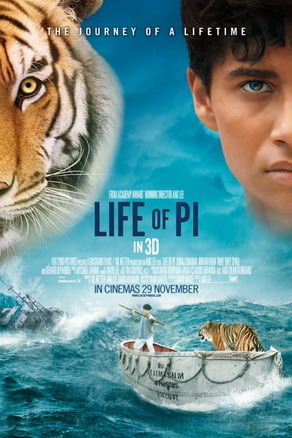Brian Clegg's Blog, page 114
July 25, 2013
A different age
In my programme of scanning in old photos I have come across my first ever school photo.

Taken probably in 1960 it might as well be in the dark ages, it looks so ancient. I have no idea what happened to the others who were at Smithy Bridge Infant School in that photo - I am not in contact with any of them. Probably the usual mix of hopes fulfilled and dreams shattered.
I love that we've got several ties and a couple of sets of braces amongst the boys. And that the poses are anything but formal. That's the firm but fair Mrs Fielding in charge. And if you're interested, I'm the one with the seriously curly hair on the right hand end of the middle row.

Taken probably in 1960 it might as well be in the dark ages, it looks so ancient. I have no idea what happened to the others who were at Smithy Bridge Infant School in that photo - I am not in contact with any of them. Probably the usual mix of hopes fulfilled and dreams shattered.
I love that we've got several ties and a couple of sets of braces amongst the boys. And that the poses are anything but formal. That's the firm but fair Mrs Fielding in charge. And if you're interested, I'm the one with the seriously curly hair on the right hand end of the middle row.
Published on July 25, 2013 01:45
July 23, 2013
Overripe cherries
 The real forbidden fruit - don't pick me!In science, one of the worst sins is cherry picking. I don't mean it's a bad move for scientists to get themselves some of the fleshy drupes of Prunus avium. They are delicious. The cherry picking in question refers to picking out bits of data that support your hypothesis and ignoring the rest.
The real forbidden fruit - don't pick me!In science, one of the worst sins is cherry picking. I don't mean it's a bad move for scientists to get themselves some of the fleshy drupes of Prunus avium. They are delicious. The cherry picking in question refers to picking out bits of data that support your hypothesis and ignoring the rest.A really bad example of cherry picking would be something like an experiment to measure the wibblability of cheese strings. (I can't be bothered to think up a real experiment.) Let's say they are expected to have a wibblability of 12 on the Kraft scale. A series of measurements come up as 8, 12, 7, 7, 13, 6, 8. Not encouraging... unless you only report data points 2 and 5. Naughty - but it happens. It doesn't have to be as explicit as that, though.
Let's imagine you are doing a psychology test that requires considerable concentration. Half way through there is a loud bang in the street. Everyone rushes to the window to see what happened. After a little while they get back to the test and continue. Let's say the current theory suggests outcome A for the test, but it could also have outcome B. So the psychos (sorry, psychologists) mark the test and they get outcome A. Clearly the incident didn't disrupt the test, so they record the data. But now imagine on marking the test they got outcome B. That wasn't expected. So it was probably the disruption that invalidated the test, because the subjects lost concentration. So they discard the data. See what they did then? Subtle cherry picking - keeping data that supported the theory, throwing away data that didn't - but it didn't seem so bad, because they had an excuse.
In politics, the usual approach is far less subtle. Politicians cherry pick all the time, presenting data that supports their case, ignoring data that doesn't. Or in the case of UK government advisor Professor David Nutt back in 2009, firing the scientist if they don't like the data. We almost expect this with politicians - but why? They shouldn't be allowed to get away with it.
However, I would say that we are much more tolerant of cherry picking when it is employed by activists and charities, and we shouldn't be. I'm afraid they too resort to cherry picking, but we tend to just get their message without any attempt to see whether they are only giving us a part of the data. This is true, for instance, of almost all campaigns for and against different forms of power, whether it's wind power or nuclear. But the example that made me write this post is the anti-globalisation movement.
While most of probably don't support the means sometimes used, many people have a sneaking regard for the message of anti-globalisation. We know those big companies (and especially banks) are rapacious uncaring monsters. And some certainly are. We know that poor people in third world countries are being exploited so we can get cheap clothes and electronics and so on. And they are. This is important stuff that needs consideration. However, I really don't think the anti-globalisation people do themselves any favours by the rampant cherry picking they employ. The picture is more complicated.
I'm currently reading a book on the global crisis by the excellent (if sometimes strangely intoning) Robert Peston, the BBC's business editor. (I'll be reviewing it when I've finished.) And he points out what a huge benefit globalisation has been to many, many millions of poor people. The fact is that living standards in the likes of China and India have been improved on a massive scale by globalisation. Frankly most of the population in places that are on the 'sweatshop' end of globalisation had totally terrible lives beforehand. Now what we mustn't do is cherry pick in the opposite direction. There are still those bad sides of globalisation. But what this says to me is that globalisation is not a bad thing - it does a vast amount of good - but that we need to do it better.
This is a message those protestors really ought to learn. Otherwise what they are campaigning for is put over a billion people back into intense poverty. And that's not really what they have in mind, I think.
Image from Wikipedia
Published on July 23, 2013 00:56
July 22, 2013
Four questions to transform your business
 I was reading a typical business guru post on Linkedin in the other day. It was telling companies how to make the best of their social media presence, and it was a load of typical worthless business-speak. I'm sorry to be so blunt, but this tosh makes my blood boil.
I was reading a typical business guru post on Linkedin in the other day. It was telling companies how to make the best of their social media presence, and it was a load of typical worthless business-speak. I'm sorry to be so blunt, but this tosh makes my blood boil.It was all about defining your goals, clarifying your vision, making sure you had a strategy roadmap, and god forbid you forgot your governance and guidelines. Does someone actually remove these people's brains and replace them with mush? Do human beings really speak like this? It was interesting to put this alongside the TV show Undercover Boss , where a senior executive from a company is secretly given a job on the shop floor (or equivalent) to see what it's really like to work there. Anyone who has a tendency to come out with business speak ought to have a go at the undercover boss game (clue - you don't need TV cameras to do this) and see if you still want to spout this garbage at the end of the process.
The sad thing in a way about Undercover Boss is how it is exactly the same lessons that get learned every time. The business processes get in the way of doing business well. The company doesn't treat its lowest paid employees as human beings. The people on the shop floor know how to improve things, but you don't talk to them. (Clue: don't think a suggestion scheme is the answer.) Running a business with employees is more about understanding people and helping them do things better to achieve your aims than it is about budgets and goals and visions and mission statements. Of course you need to know what you are trying to do and to keep an eye on the finances - but as soon as you start communicating in business speak you lose the plot.
If you are a senior executive in a company with employees, I think you need to ask yourself some serious questions - and do something about the answers:
Do you know from experience what working life is like for your lower paid workers? Try out (anonymously if you can) some low paid, customer facing (if available) jobs for several days.Do you personally talk one-to-one with people doing the lower paid and customer facing jobs, asking them how things could be done better? Do it. Regularly. Don't rely on feedback forms and management reporting. These are people. Talk to them. And if you promise them change, make sure it happens.Do you find yourself spouting management speak? This is no way to talk to ordinary human beings. Try explaining your business to a ten-year-old. What you say to them is what your business is all about, not your vision and your mission statement.Do you personally talk to your customers on a regular basis? Feedback forms and customer response systems give you an anodyne and misleading picture. At least once a week personally talk to some real customers about their experience. What went well, what you could do better, what they would like to see.It's not rocket science - and this is the main problem. If you listen to management gurus like my friend with the strategy roadmap to good governance (or whatever it was), they have to come out with this complex and meaningless rubbish, because you aren't going to pay them $5,000 a day for them to tell you to talk to your staff and your customers and to make things better as a result of what you hear. And yet that will do so much more for your business than any recommendation you might get from your friendly neighbourhood guru.
So what are you waiting for? Are you taking action on those four questions? Get started today.
Published on July 22, 2013 00:55
July 19, 2013
Taking a peer at piers
 I've been sent for review a delightful little book called Piering Around Britain by John Choopani. It's not exactly my usual reading fare, but it certainly makes a change from quantum physics. I was really pleased to have a chance to look at it because I love piers - a stroll down the pier really makes a seaside visit for me.
I've been sent for review a delightful little book called Piering Around Britain by John Choopani. It's not exactly my usual reading fare, but it certainly makes a change from quantum physics. I was really pleased to have a chance to look at it because I love piers - a stroll down the pier really makes a seaside visit for me.The author clearly has his preferences, but I'm happy with both the extravagantly camp pleasure pier, crammed with entertainments and penny arcades, and the more old fashioned Victorian splendour of some of our 59 surviving piers. 'Surviving', it has to be said, is a close call with some of the sad specimens Choopani visits, though many others are still worth a visit.
The format is a very leisurely tour with visits to piers happening as and when they fitted in with the Choopani family holiday schedule. The result is a very haphazard structure - in some ways I would rather it were either alphabetical or a sequential visit around Britain's coast, but at least it fits with the casual and often entertaining storytelling style of the text which takes in any characters or cream teas encountered along the way.
 Boca Raton pier - not in the book, which sticks to the UK.
Boca Raton pier - not in the book, which sticks to the UK.The Boca wildlife is more exotic, but you can't beat a
British pier for the genuine period experience.There are plenty of colour photographs, some a little low in contrast (particularly the under-the-pier pillar shots), but giving a good visual record. I was less enthusiastic about the 'arty' way the shots are printed at strange angles and don't always clearly relate to the text, but I could live with that.
Overall this is a gentle, easy tour of these fascinating, often Victorian or Edwardian remnants of a past age. It won't take long to read it, but you may well then use it as inspiration to visit a few piers yourself - and at least with Choopani as your guide, you will know which to select for the best experience. There is also a very sad list at the back of piers that are no longer standing, at least one of which (in Morecambe) I remember fondly from childhood.
The front labels the book as a 'not-for-anoraks' photographic tour, and I can see what the author means. This isn't something for the real pier buffs, but for us ordinary folk who appreciate a stroll over the ocean waves and a brisk puff of sea air in the face.
You can, of course, get a copy from Amazon.co.uk and it is also listed on Amazon.com, though at the time of writing there were no copies available.
Published on July 19, 2013 00:32
July 18, 2013
Vigilante speed traps or concerned locals?
 The other day I passed a speed trap clearly operated by amateurs rather than the police, so I stopped and went back to take a look at what they were up to.
The other day I passed a speed trap clearly operated by amateurs rather than the police, so I stopped and went back to take a look at what they were up to.There seemed rather a lot of them to operate a speed camera - I don't know if it was for self-defence in case they were attacked by irritated motorists, though I suspect it's more likely they were the kind of people who enjoy wearing day-glo vests and appearing official. I rather expected they would object when I took their picture, but they were quite happy about it.
Now I've lived in a village where people drove through too fast, and I would mouth rude things at them as they did so - but I am really not ecstatic about this kind of action. I don't think amateurs should be handling complex equipment, especially if they are going to do anything more than take a survey.
There were several things that worried me about the way they were operating. I clearly have no idea if the speed camera was well calibrated - but would they either? More to the point, the operator in the left of the photo was shouting out speeds. So she was going '32, 35, 31, 35, 36' while the guy at least three metres behind her was noting these down. Two things worried me here. I don't know enough about radar guns to know their recovery time/how long they need to monitor a car before they have an accurate speed reading, but she was reeling off these numbers at faster than one a second. That sounded too frequent.
If they were just doing a survey, my second issue isn't important - but if they were also noting car registrations, there is a big issue with the way these were being recorded, as the guy with the clipboard was well separated from the speed gun, and was having to guess which cars the operator was shouting speeds for. She gave no other information, so there was no clear link between speed and car. It would have been very easy to get out of synch.
As I mentioned, I do think we need to keep speeds at safe levels - but I'm really not sure that speed trap vigilantes are the answer.
Published on July 18, 2013 00:01
July 17, 2013
Is it time to downgrade witness evidence?
 I was listening to the radio the other day when former newspaper proprietor Eddie Shah was describing the trauma of being put in the dock for something he didn't do, based solely on the evidence of another person. Even if the witness is not the alleged victim, time and again we see cases that are far too dependent on witness evidence. In science there's a saying 'data is not the plural of anecdote.' We don't accept something as scientific evidence just because someone claims to have seen it. And yet witness evidence in court is nothing more than anecdote. And there are very good demonstrations that people are hopeless at providing accurate accounts. Witness evidence stinks. I give a very strong example of this in my book
Extra Sensory
:
I was listening to the radio the other day when former newspaper proprietor Eddie Shah was describing the trauma of being put in the dock for something he didn't do, based solely on the evidence of another person. Even if the witness is not the alleged victim, time and again we see cases that are far too dependent on witness evidence. In science there's a saying 'data is not the plural of anecdote.' We don't accept something as scientific evidence just because someone claims to have seen it. And yet witness evidence in court is nothing more than anecdote. And there are very good demonstrations that people are hopeless at providing accurate accounts. Witness evidence stinks. I give a very strong example of this in my book
Extra Sensory
:On December 4, 1901 there was as a horrendous incident during a seminar on criminology at the University of Berlin. As Professor Franz von Liszt gave his lecture, one of the students interrupted to give an alternative viewpoint to the professor’s “from Christian morality.” A second student jumped up and disagreed profoundly. He said that he was fed up of with these Christian morality arguments. The first student was incensed. He pushed the desk over and strode over to his opponent, pulling a gun from under his coat. There was fight, the two students wrestling for control until the gun went off. The second student fell to the floor, apparently dead.
Not surprisingly, the rest of the class was in shock. Von Liszt picked up the gun and asked for attention. He apologized, telling them that he had staged the event in order to perform an experiment. He now wanted everyone present to write down exactly what they had seen. Still shaken, they all obediently wrote out witness statements. And here’s where it gets interesting. The versions that the students gave differed wildly. This was no distant memory and featured no ordinary everyday event. They were giving their recollection of something amazing that had been seared on their memories just minutes before.
When the different reports were compared there were, for example, eight different names given for the person who started the fight. Across the observers there were wildly differing accounts for the duration of the event, the order in which things happening and how the whole scene finished with von Liszt’s explanation. Some were convinced that the gunman had run from the lecture room – which he hadn’t. He had remained standing over the body.
The point von Liszt hoped to make – and in which he was successful far beyond even his own expectations – was to show just how unreliable witnesses are when giving evidence in court. And it is totally bizarre that we still place so much faith in witness evidence in trials today, given the clear example of this and many other similar psychology experiments since. Witnesses are terrible at getting the facts right. They really aren’t good enough to rely on in court. Interestingly von Liszt found that the inaccuracies were worst when describing the events that were most dramatic – those, for example, involving the gun. It’s as if the unexpected nature of the event makes us particularly bad at recalling exactly what happened.There is inevitably an unfortunate outcome of deciding that witness statements unsupported by other evidence is unreliable, which is that it is pretty well impossible to progress any trial based solely on the account of the victim. Yet surely we shouldn't allow innocent people to go through the whole traumatic trial process and potentially be found guilty merely to make it easier for those who don't have corroborative evidence?
When I first heard about the Eddie Shah case I thought he should have the right to sue his accuser for damaging his reputation. After all, if he is innocent, then his accuser is lying. And maybe that still is the case. But a more important outcome should be that this kind of trial is prevented from happening in the first place. Witness evidence alone is simply not good enough. Anecdotes, however forcefully put, will never be data.
Image from Wikipedia
Published on July 17, 2013 00:26
July 16, 2013
Awash on the Dirac sea
 I've written two books about infinity, most recently the fun illustrated title
Introducing Infinity
, and it's a subject I enjoy writing and thinking about. But for physicists, infinity often means a problem. While we can conceive that the universe might be infinite, because we only ever deal with a part of it, when infinity rears its head in calculations, it usually means trouble. This most famously arises in quantum electrodynamics, the science of the interaction of light and matter on the quantum scale. The solution there has been renormalisation - in effect, putting in the real observed values of some quantities to make the infinities go away. And this works, but it's a bit uncomfortable. Elsewhere, such as at the moment of the big bang or in the heart of a black hole, the infinities are taken to mean that our current theories break down at that point and we need to find new ways to look at what's happening.
I've written two books about infinity, most recently the fun illustrated title
Introducing Infinity
, and it's a subject I enjoy writing and thinking about. But for physicists, infinity often means a problem. While we can conceive that the universe might be infinite, because we only ever deal with a part of it, when infinity rears its head in calculations, it usually means trouble. This most famously arises in quantum electrodynamics, the science of the interaction of light and matter on the quantum scale. The solution there has been renormalisation - in effect, putting in the real observed values of some quantities to make the infinities go away. And this works, but it's a bit uncomfortable. Elsewhere, such as at the moment of the big bang or in the heart of a black hole, the infinities are taken to mean that our current theories break down at that point and we need to find new ways to look at what's happening.However, there is another class of infinite entities that is tolerated by some, because they produce useful results, but that others find a little uncomfortable. Two examples spring to mind, both from the quantum world - the Dirac sea and the many worlds interpretation of quantum physics. I'd like to take a look at the less frequently covered of these, that unusual infinite ocean.
Paul Dirac was a superb (if rather strange) British physicist who was one of the leading lights in quantum theory, though he tends to be less well known in the outside world than the likes of Heisenberg or Schrödinger. One of his crowning achievements was to extend Schrödinger's wave equation for some types of quantum particle, which describes the behaviour of those particles, so that it matches the real world. The original version was not relativistic - like Newton's laws it was an approximation that assumed particles moved fairly slowly. But an electron, for example, is often no slouch and it's Dirac's equation you need to keep track of it, not Schrödinger's.
However, something interesting emerged from Dirac's work. The equation has a kind of symmetry of solution that makes it equally possible to have positive and negative energy particles. Sometimes the negative parts of such equations have just been ignored. This happened most famously with 'advanced waves' - Maxwell's equations, describing electromagnetism and light, suggest there should be photons that travel backwards in time from destination to source as well as the usual forwards ones. These were simply ignored until Richard Feynman and John Wheeler realised they could be used to explain another oddity of physics. Dirac, though, did not simply cast his negative energy electrons away. But that led to a problem.
Light is typically produced when an electron drops an energy level. The electron loses energy and this is emitted as a photon of light. Eventually the electron gets to a 'ground state' below which it can't drop any more. But if negative energy levels were allowed, as Dirac's equation suggested, electrons should continue dropping in energy for ever, blasting out vast quantities of light. They don't. So Dirac came up with a the idea that the vacuum - empty space, if you like - contained an infinite sea of negative energy electrons, filling up all the negative energy levels, so your ordinary, everyday electron could never drop into negative energy.
This seems a very unlikely and highly wasteful proposition, requiring as it does this infinitely deep and wide sea of inaccessible particles. However it proved a very productive idea. The model predicts that there will sometimes be holes in the sea - gaps where a negative energy electron is missing. As it happens, a missing negative energy electron is identical to a present positive energy, positively charged equivalent of an electron. Dirac predicted these should exist, and a couple of years later, the positron was discovered. This hypothetical infinite negative energy sea enabled Dirac to predict there was antimatter.
Does the sea have a 'real' existence? That's a difficult one. Some physicists would say yes, while others would hedge their bets with philosophical waffle about the nature of reality. The fact remains that Dirac's infinite sea of negative energy particles has played a fundamental role in the development of physics.
That's what I call a big idea.
Published on July 16, 2013 01:00
July 15, 2013
Life of Pi-ty
 I watched the movie of Life of Pi the on Saturday night, and I wish I hadn't. I had avoided it for a long time because the story sounded so ludicrous, but we wanted to watch a movie, it was there on iTunes, and we hadn't seen it.
I watched the movie of Life of Pi the on Saturday night, and I wish I hadn't. I had avoided it for a long time because the story sounded so ludicrous, but we wanted to watch a movie, it was there on iTunes, and we hadn't seen it.Now admittedly the story makes a bit more sense when you know it's an allegory on the nature of religion - which none of the people enthusing at me to read/watch it had bothered to mention, but that doesn't justify it. I can't see the point of having a long, laboured, silly story to put across the message 'religion might be fiction, but it is a better story than the alternative.' Just write down that sentence and move on. Don't make me waste over two hours to get that rather limp, cod psychology message.
As for the film itself, I enjoyed the first bit about Pi's background a lot, but as soon as they got to the shipwreck I hated it. In part because it is just such a silly story, but also because the CGI, which everyone says is wonderful, really let it down by being far too obvious. Three examples: the sinking ship looked all wrong, the water surfaces were far too mirrored and/or oily and the tiger moved incorrectly and had irritating anthropomorphic facial expressions.
Now someone is bound to say that it actually should look not quite right to make it more dream-like. This is wanting to have your cake and eat it. If the CGI is great, it's good because it's great CGI, and if the CGI is bad it's good because it conveys the unreal nature of the storyline. Apart from being cheating logic, this is rubbish, because dreams don't look unreal. You might, in a dream think 'Ooh, that doesn't usually happen,' (though usually you accept the weird stuff til you wake), but you will never think 'Hmm, this world looks like bad, poorly textured CGI.' It's not dream-like, it is just poor special effects.
Overall, then, Pi might be a transcendental number, but this film was anything but transcendental, bringing me down to earth with a bump.
Image from Wikipedia
Published on July 15, 2013 00:01
July 12, 2013
Got the exoplanetary blues
 That imageThere has been a lot of news coverage in the last day or two of the discovery of a blue exoplanet - a planet orbiting another star. It is quite a feat to detect colour at this distance, but I feel that the news coverage is tainted by a combination of misapprehension and downright naughtiness.
That imageThere has been a lot of news coverage in the last day or two of the discovery of a blue exoplanet - a planet orbiting another star. It is quite a feat to detect colour at this distance, but I feel that the news coverage is tainted by a combination of misapprehension and downright naughtiness.To begin with, why should we care that the planet is blue (and hence splash it across the media)? After all, it has to be some colour. So what if it's blue? The only reason I can think for getting excited is that traditionally this colour has been associated with life. We know that Earth is primarily blue when seen from space because of its oceans and so link this with a friendly environment. What this misses is that Earth isn't the only planet in the solar system that is blue. Both Uranus and Neptune are blue too.
This blue coloration is not because these gas giants distant from the Sun are ideal for life. Quite the reverse. It is because that's the right sort of colour for a methane atmosphere. So we shouldn't get too excited, given two out of the three blue planets we know well aren't anywhere near inhabitable. In fact, to give the news media their due, they have all reported that HD 189733b, located around 63 light years away, is probably blue because of liquid or fragmentary silica in the atmosphere. And most have pointed out that it is a gas giant. But given that, it's not quite clear why they have got so excited about it. There is something worse, though.
Pretty well every bit of coverage I've seen has carried this stunning image from NASA/ESA. And why wouldn't they? It puts some of the pictures of planets in our own system to shame, let alone a planet 63 light years away. Of course, the reason it is so good is that it is an artist's impression. It's not a photograph. The colour detection has been through changes in the colour spectrum when the planet passes behind its star, not through direct observation, and certainly not through stunning photographs. And yet almost all the coverage I've seen has not mentioned that this picture is a fake.
Take, for instance, the write-up in the usually excellent i newspaper. They have given it a quarter page. Of that, maybe two thirds is the picture and the rest is a small text box. The closest it comes to saying the image isn't genuine is saying the planet is 'a deep cobalt blue, data gathered by the Hubble space telescope shows.' I'm sorry, I can guarantee you that a fair percentage of even the excellently educated readers of the i will come away convinced that they have seen a picture of this planet. It wouldn't be hard to put in an 'artist's impression' caption.
If you think I am being over concerned, it is because I think this demonstrates a widespread attitude in the media that you can loose and free with science reporting. Just imagine this was a story about a celebrity committing an offence and the paper mocked up a 'photograph' of it happening without labelling it as an artist's impression. It would cause on uproar. Just because this is science doesn't mean that such deception is acceptable.
Published on July 12, 2013 01:32
July 11, 2013
Why I hate company suggestion schemes
 When I'm helping companies be more creative, one of the first things I recommend is that they get rid of any suggestion scheme. These are usually in the form of a prize competition. You send in your ideas and if they company likes them and implements them you get a reward. It might seem these are a good idea - but they are poison. Here's my analysis from my book
Creativity and Innovation for Managers
:
When I'm helping companies be more creative, one of the first things I recommend is that they get rid of any suggestion scheme. These are usually in the form of a prize competition. You send in your ideas and if they company likes them and implements them you get a reward. It might seem these are a good idea - but they are poison. Here's my analysis from my book
Creativity and Innovation for Managers
:There was a time when the staff suggestion scheme was the beginning and the end of an innovation agenda in most companies. The theory seemed good. Anyone in the company could contribute a suggestion. When they had a bright idea (or brainwave, or whatever glossy term was chosen for the scheme), they filled in a form, popped it in the post and before long the best ideas would be implemented, with the idea merchant awarded a nice, fat cash bonus.
It has been recognised for a long time that suggestion schemes aren't very effective, given the resource available and the meagre results they generally produce. What is now being suspected is that suggestion schemes in their traditional format are actually disadvantageous. It's not just that they are harmless but useful, they can be destructive.
The suggestion scheme problem has many causes. The administration of such schemes is a thankless task. Generally it is given a low administrative priority. So it can take a long time for an idea to be processed - sometimes so long that the idea is no longer current. When the idea comes to be assessed, there is often a natural reluctance from the assessor to accept it. A classic reaction is 'we've tried it/thought of it before and it didn't/won't work'. The trouble is, this kind of assessment totally overlooks the point that most new ideas are easy to shoot down. They need to be nurtured, not assessed into an early grave.
The negatives don't end there. Many schemes set the level of award on a proportion of the cost saving the idea generates. At a stroke this disenfranchises any ideas that involve revenue enhancement rather than cost cutting. In fact, it generates a mindset that cost cutting is more important than revenue generation - a fatal position if a company is to survive and grow. To add insult to injury, many schemes distinguish between manager and worker, or between areas of the company. Managers aren't allowed to take part because 'it's their job to have ideas'. Yet an engineer who thinks of a way of reusing a flange sprocket instead of buying a new one (surely his job too) gets a fat cheque.
The outcome is a system that is divisive, generates negative feeling and stresses costs over revenue. This does not mean that is impossible to get creative input from the entire company. Quite the reverse. Just that the suggestion scheme is not an appropriate vehicle. This chapter looks at a number of ways of making innovation a part of the company culture. To support that, ideas from the staff need to be encouraged. But they should be able to work outside of a formal scheme, sending them directly to those who can make it happen, or to their manager if they don't know who to send it to. Effective use of e-mail within the company is probably the strongest vehicle for making this happen. If there is a culture that it is okay to send an e-mail to anyone - the chief executive included - with an idea or suggestion, ideas will flow from the most unexpected sources.
There then follows the usual painful process of suggestion scheme mechanics. It is interesting that there is a creativity technique called 'Reversal' where, in order to solve a problem, you first try hard to make the opposite happen. For example, when trying to improve communications in a company, you first say what would positively discourage communications, then turn round the ideas that arise to stimulate positive communication. This scheme shows every sign of reversal being used without ever turning things back round. For example, could you think of a better way to make sure that contractors and other non-permanent staff did not think of themselves as part of the company, and did not have buy-in to what the company was trying to do?
Reward should not be through a separate scheme, implying that creativity is something special you do once in a lifetime, but through the regular company reward scheme. It shouldn't be a case of 'we can give you a cash bonus because having this idea isn't your job'. Instead, having an idea has to be everyone's job, and those who do it well need to be rewarded appropriately, just as they are rewarded for other aspects of their job.
If you want to see how really not to do it, here is a real example I found:
While researching this book, I contacted a number of large companies, asking what they did to further creativity and innovation in the company. One multinational gave a good example of why suggestion schemes don't work. To avoid embarrassment, the company is referred to below as X.
The company's PR department, on a second contact said 'I found this on the intranet - I didn't even know we had anything like this.' What she referred to was a document explaining the suggestion scheme. Now the document had all the right buzzwords, but it managed to make innovation about as exciting as filling in an expenses form. For example: "To gain and sustain competitive advantage, X must stay ahead of the field in innovation as well as cost reduction and efficiency. All employees have a part to play in identifying new practices etc. to enhance revenue generation, improve the way the company operates and maximise continuous improvement.' Just in case the wrong people got hold of the document: 'The arrangements explained in this document are for all employees of X plc. Non-X people may offer suggestions: they will not receive awards if their suggestions are used, but their contribution will be recognised.'
Published on July 11, 2013 00:16



